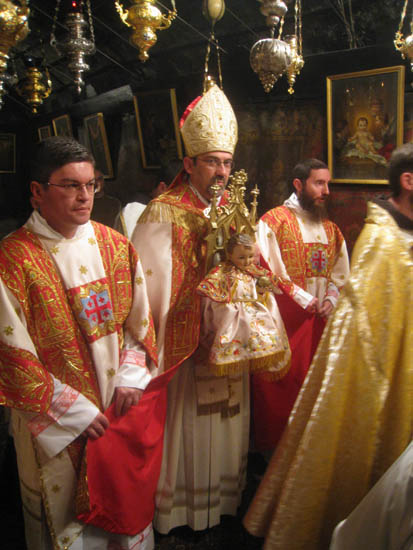
Of the three solemn entries into Bethlehem (1st Sunday of Advent, December 24, January 5), that of the Epiphany is the least impressive. But this year it was of a particularly austere nature because of the events that are shaking the country during these days.
Although, as is customary, the Israeli police and then the Christian community of Jerusalem came to greet the Custos at Saint Savior’s before the procession accompanied him to Bethlehem, hearts were not in a festive mood.
The delegations from Beit Jala and Beit Sahour were present at the stops at Mar Elias and Rachel’s tomb, but silence was called for. This was also the case in the deserted streets of the city, through which the scouts did not march, thus signifying compassion for Gaza.
After singing the Te Deum, the parish priest of Saint Catherine’s parish, Friar Samuel Fahim, spoke to the assembly as follows: “On the feast of the Epiphany, I would like to welcome the Custos, Pierbattista Pizzaballa, in the name of the parish and of all the inhabitants of Bethlehem. What is happening in our region during these days is very sad and lets us touch with our hands what is written in the Gospel, when so many innocent children were massacred. But then, Jesus was with them, and still today Jesus is in our midst. That is why we turn to the Lord and beg him to transform our sorrow into joy and war into peace. This is the spirit in which we want to live the feast of the Epiphany.”
For his part, the custodial vicar, Friar Artemio Vitores, answered the journalists’ questions, underlining: “The bitterness we feel during this entry pushes us to see further and to enter more deeply into the mystery of the Incarnation. We went through the door of humility, the door of humiliation. If the spirit of Christmas carries us more easily towards celebrating the gift of Life, the situation today leads us to live the humility and weakness of God who became flesh. But the child who was born here in this poverty is the Prince of Peace. What we must do more during these days is to pray and to call upon that Peace, never losing hope.”
The liturgies of the feast succeeded one another throughout the day for the many Franciscans who had come.
On January 6, a large gathering came to the pontifical Mass, at which the Custos presided and for which the four Consuls General were present. Because of the current events, the latter declined the traditional invitation to lunch.
In the afternoon, the procession of the magi surrounding the child Jesus and bearing gold, frankincense and myrrh brought together a large crowd of pilgrims and local Christians, all of whom entrusted themselves to the Prince of Peace who was revealed to the nations.
MAB
Although, as is customary, the Israeli police and then the Christian community of Jerusalem came to greet the Custos at Saint Savior’s before the procession accompanied him to Bethlehem, hearts were not in a festive mood.
The delegations from Beit Jala and Beit Sahour were present at the stops at Mar Elias and Rachel’s tomb, but silence was called for. This was also the case in the deserted streets of the city, through which the scouts did not march, thus signifying compassion for Gaza.
After singing the Te Deum, the parish priest of Saint Catherine’s parish, Friar Samuel Fahim, spoke to the assembly as follows: “On the feast of the Epiphany, I would like to welcome the Custos, Pierbattista Pizzaballa, in the name of the parish and of all the inhabitants of Bethlehem. What is happening in our region during these days is very sad and lets us touch with our hands what is written in the Gospel, when so many innocent children were massacred. But then, Jesus was with them, and still today Jesus is in our midst. That is why we turn to the Lord and beg him to transform our sorrow into joy and war into peace. This is the spirit in which we want to live the feast of the Epiphany.”
For his part, the custodial vicar, Friar Artemio Vitores, answered the journalists’ questions, underlining: “The bitterness we feel during this entry pushes us to see further and to enter more deeply into the mystery of the Incarnation. We went through the door of humility, the door of humiliation. If the spirit of Christmas carries us more easily towards celebrating the gift of Life, the situation today leads us to live the humility and weakness of God who became flesh. But the child who was born here in this poverty is the Prince of Peace. What we must do more during these days is to pray and to call upon that Peace, never losing hope.”
The liturgies of the feast succeeded one another throughout the day for the many Franciscans who had come.
On January 6, a large gathering came to the pontifical Mass, at which the Custos presided and for which the four Consuls General were present. Because of the current events, the latter declined the traditional invitation to lunch.
In the afternoon, the procession of the magi surrounding the child Jesus and bearing gold, frankincense and myrrh brought together a large crowd of pilgrims and local Christians, all of whom entrusted themselves to the Prince of Peace who was revealed to the nations.
MAB

